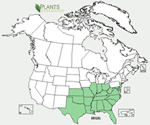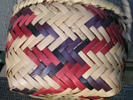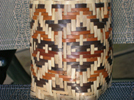Endemic to the U.S., Arundinaria is the only genera of bamboo native to North America. Large areas of rivercane (Arundinaria gigantea (Walter) Muhl.), known as canebrakes, were once abundant along river bottoms in the southeastern United States . However, canebrakes are now considered critically endangered ecosystems due to agriculture, grazing, fire suppression, and urbanization.
 The potential loss of these critical habitats has spurred efforts in drawing attention to their importance and investigating restoration techniques. Canebrakes have been recognized as critical in filtering sediments and nutrients from agricultural runoff , providing habitat for threatened and endangered fauna, and providing raw materials for the manufacture of hundreds of everyday objects ranging from sandals to coffins. The production of cane baskets has been passed along through generations of Native American tribes of the Southeast, and persists today among the eastern bands of expelled tribes (Cherokee, Choctaw, and Chickasaw).
The potential loss of these critical habitats has spurred efforts in drawing attention to their importance and investigating restoration techniques. Canebrakes have been recognized as critical in filtering sediments and nutrients from agricultural runoff , providing habitat for threatened and endangered fauna, and providing raw materials for the manufacture of hundreds of everyday objects ranging from sandals to coffins. The production of cane baskets has been passed along through generations of Native American tribes of the Southeast, and persists today among the eastern bands of expelled tribes (Cherokee, Choctaw, and Chickasaw).
Restoration efforts, however, have been hindered by the limited supply of plant materials. Like other bamboos, rivercane flowering is generally described as gregarious and sporadic (perhaps on a 30-40 year cycle), making seeds hard to come by. Seeds, when produced, have low viability and are recalcitrant, contributing to low seedling success rates. Established rivercane culms propagate vegetatively through rhizomes, making transplantation of established culms a viable, though labor-intensive, restoration method. Currently, researchers are investigating methods of vegetative propagation in order to increase the supply of plant materials for restoration projects.

